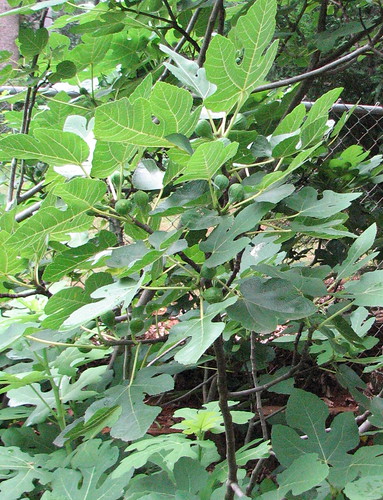How to Choose and Grow Fig Varieties for the Southeast
If you live in USDA zone 5 or warmer, you can grow figs.
If you are in a colder area, the trick is to put your fig in a microclimate (next to the sunny wall of a building, beside a sheltered, blacktop driveway, etc.). You can also try pruning and wrapping your fig in the winter but if you selected a hardy variety that should not be necessary.
The next step is to pick which variety (or varieties) of figs you want to grow.
‘Brown Turkey’ is the most popular fig in our area, though the variability in the fruit size seems to indicate it is a strain rather than a true variety. Most strains are hardy to zone 5, but there may be fluctuations here as well.
‘Celeste’ and ‘Mission’ are also common. If you have really cold weather look for a northern bred variety like ‘Chicago Hardy’ which may die back to the ground in winter but will sprout and fruit before the following autumn. It has been recorded hardy at 3000 ft above sea level in Europe.
If you want to try a lot of different sizes, colors, and flavors, check out the East Coast Figs website.
An easy fig tree source is a neighbor or friend’s tree if they happen to have one. Figs are one of the easiest plants to root, so just take a cutting and stick it in a pot of sand or soil. Make sure at least one bud is beneath the soil and do not disturb the plant until it begins making new leaves. Keep the soil about the consistency of a wrung-out sponge while it is rooting, not too wet nor too dry. If you know you are lazy about watering, stick your fig cutting in an extra large clay pot, mulch the top with leaves, and bury the pot right in the garden. A shady site is best. Later, you can dig up your pot and transplant the fig.
Figs aren’t too fussy about soil conditions, though they prefer decent drainage. They handle drought well once established and also put up with heavy clay or rocks. Sometimes the older trunks begin to show signs of decay and need to be pruned back. Once they are removed, the fig’s root system will send up multiple suckers to take their place. It is best not to prune more than 1/3rd of the plant in one season.
New figs are best planted in early fall or mid-spring. Make sure they do not dry out completely during drought so that they will grow quickly and build a healthy root system. Though they appreciate amended soil and mulch, it is not absolutely necessary. Prevent mulches from resting against the trunk or your fig may rot.
Figs usually produce two crops per season. This is especially nice if your area experiences a late freeze — you may lose your first fig crop but you can expect a second one before fall. The first figs your tree produces in the spring are called “brebas” and are borne on the previous year’s wood. The second, or main crop, usually ripens in late summer or early autumn on the new year’s wood. Brebas figs are generally larger in size than the main crop figs.
5 thoughts on “How to Choose and Grow Fig Varieties for the Southeast”
Comments are closed.


Susan - September 15, 2009 12:42 am
Your posts are so helpful; I always enjoy the rooting tips too. Thank you!
What I’ve found funny about figs is that I have a BAD skin allergy to one type of green fig (as far as i know, it’s just one type & it’s not the lemon fig) if I come in contact with the leaves and moderate amounts of sap… Found this out the hard way. Very itchy & very painful.
Aaron - September 15, 2009 12:51 am
The “third” crop is the fig preserves that you can eat all year long which are super tasty. For canning purposes, brown turkeys have great flavor and the dark purple (mission figs?) add a beautiful pink/purple color to the preserves. Instead of loading the preserves up with refined sugar for sweetener, Susan and I started adding fresh squeezed muscadine, scupernong, and/or neptune grape juice. All of this fruit and more are available at The Happy Berry in Six Mile (30 minute car ride from Greenville).
On another note, it’s amazing how many people we know with great fig trees who don’t eat the fruit or even know that it is edible!
Sustainahillbilly
Twitter: appalachianfeet
- October 26, 2009 1:46 pm
Agreed about the uneaten figs!
Sometimes you can find sources of unharvested yard orchards on Craigslist. Last week I went to pick up black walnuts at a home where the resident didn’t want them all. Will blog post on it soon!
MsRoser15 - September 18, 2012 11:03 am
Can I dig up my fig tree/bush in Sept. an replant it in a better location? Do I have to wait until it is dormant?
Sustainahillbilly
Twitter: appalachianfeet
- January 16, 2013 10:10 am
I would wait until it is dormant and give it extra winter protection after you move it.